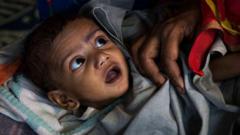In a groundbreaking study led by Ashwini Deshpande from Ashoka University and Rajesh Ramachandran from Monash University, significant insights into India's child stunting crisis have emerged. Official data indicates that 35% of India’s 137 million children under five years old are stunted, a rate that surpasses even those in several Sub-Saharan African countries. While both regions account for a staggering 70% of the world's stunted children, India’s current stunting rate of 35.7% reflects a deeper, systemic issue that researchers argue stems from caste discrimination.
Stunting, defined as a child being shorter than the expected height for their age due to nutritional deficiencies, indicates critical gaps in health and wellness. The early years of a child's life are crucial, laying the groundwork for future development. Research shows that children from marginalized communities, particularly Dalits and Adivasis, suffer disproportionately from malnutrition. In contrast, children from non-stigmatized caste groups display significantly lower stunting rates.
The research highlights that while both India and Sub-Saharan Africa share challenges regarding child nutrition and stunting, the key differentiating factor in India is its deeply rooted caste hierarchy. Disparities in access to nutrition, healthcare, and sanitation persist despite decades of affirmative action. The statistics reveal that children from higher-ranking caste backgrounds face up to 20% lower stunting rates compared to their marginalized peers.
The complexity surrounding India’s stunting crisis has sparked various theories. While some attribute differences in height to genetic factors, others point to the historical improvements in nutrition that have diminished these disparities over generations. Nevertheless, it is clear that socio-economic status and maternal education remain major determinants of a child’s nutritional status.
The analysis draws from extensive demographic and health surveys, revealing stark disparities within India's social fabric. With over half of India’s under-five population historically stunted, the need for targeted interventions focusing on the socio-economic and cultural determinants of child nutrition has never been more pressing.
In developing solutions to address stunting, the focus must go beyond generic health interventions to encompass the intricate layers of social identity, particularly caste. The study underscores that ignoring these factors risks perpetuating the cycle of malnutrition for vulnerable populations in India.

















